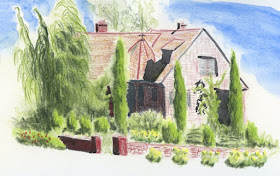 |
| Pencil Art Workshop by Matt Rota |
(Although I usually save quibbles for the end of a review, as
a writer, I must begin with this pet peeve: The author consistently uses the
term pencil interchangeably with graphite. The pencil is a form that can
contain a variety of media, including graphite, pigment, charcoal, pastel, etc.
Using the term pencil is like using
the term paint – do you mean
watercolor, oil, acrylic, latex, or will any kind of paint suffice? For a writer
to interchange the specific with the generic reduces understanding instead of
expanding it. End of editorial rant.)
As a pencil geek, I was delighted that the book’s introduction
included a brief timeline of pencil history (and by pencil, the author means woodcased graphite pencil history). I
always find material history fascinating and generally lacking in most art
technique books that otherwise include detailed information about tools and supplies.
 |
| Timeline of graphite pencil history |
The first two chapters cover drawing with line and drawing
with tone. In the line section, I was especially interested in a series of
process examples showing how varying line weights can be used to add depth and focal
emphasis to a drawing. The chapter on tone was a good capsule of the same
techniques I learned from Eduardo Bajzek,
including using an eraser as a drawing tool.
 |
| Drawing with line |
 |
| Drawing with tone |
Of particular interest and relevance to me is the chapter on
Drawing Quickly, which is essentially about sketching on location. I admire
the author’s capture of people in single-line gestures that evoke the poses so
well. Rota also shows examples of how he builds larger compositions, using varying
line weight and tone to give depth as well as detail to a sketch.
 |
| Quick captures of people with simple gestures |
A curious part of the book is the chapter on Photorealistic
Drawing. While I have no interest in creating photorealistic drawings myself,
it was intriguing to understand what photorealistic artists strive for to keep
their work from literally reading like a photograph. Despite how paradoxical
that sounds, it makes sense. For example, photos often reveal a spot of light
made by the flash that doesn’t look natural, so the flash effect must be
avoided while retaining the realism. Hmm. Not my bag, but fascinating anyway.
In addition, this chapter helped me understand why I can often look at a
painting and realize instantly that it was made from a photo instead of from
life – though I’m not always able to articulate exactly why.
An unexpected chapter is one called Adding Color. In most
other books I’ve read on drawing with graphite, color is not discussed. If
graphite is used with paint, it is typically used only in the preliminary
drawing that would later be erased or concealed by paint. Here, Rota shows how
graphite can be combined with watercolor, colored pencil, ink or gouache so
that each enhances the other in unique ways.
 |
| Instructions for applying graphite to a watercolor painting |
Each chapter ends with a drool-worthy gallery of graphite
art featuring the methods discussed in that section.
While I wouldn’t recommend this book to novices who are just
beginning to learn to draw, it would be inspiring to intermediate and even well-seasoned
artists who want to push graphite beyond what they might typically find in how-to
books. And the eye candy would be inspiring to anyone.



















































